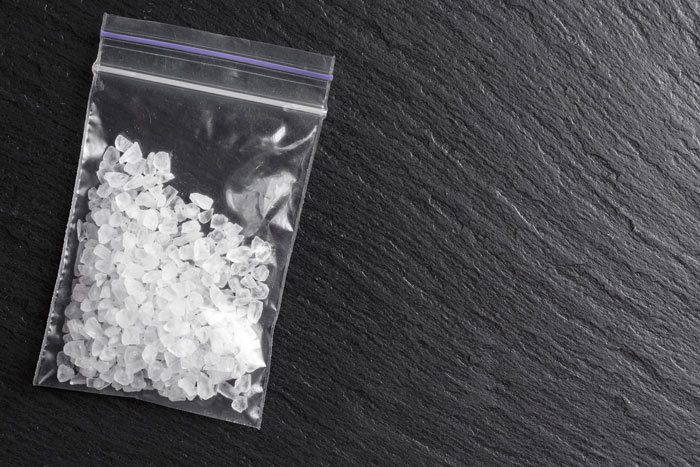 The opioid epidemic may attract more attention, but the United States is still struggling to deal with an epidemic of methamphetamine addiction. A powerful stimulant that can lead to addiction with just one use, crystal meth is cheaper, more potent, and more easily available than ever.
The opioid epidemic may attract more attention, but the United States is still struggling to deal with an epidemic of methamphetamine addiction. A powerful stimulant that can lead to addiction with just one use, crystal meth is cheaper, more potent, and more easily available than ever.
A Widespread Problem
Most of the meth in the United States comes from large Mexican labs, and just $10 can buy enough to get a person high for a full day or two. The drug can also be made at home using common household chemicals such as ammonia, battery acid, and the pseudoephedrine found in many cold medicines—creating an amateur science experiment with potentially deadly consequences.
On the street, users refer to meth as ice, crank, or crystal. The shiny crystals or hard blue or white rocks can be smoked, snorted, or injected. Users feel energetic, euphoric, and invincible.
Meth addiction, like other types of substance use disorders, can affect people of all ages, races, genders, and socioeconomic backgrounds. However, males, middle-aged adults, and people who live in rural areas have been particularly hard-hit by the meth epidemic. Opioid users also have an increased vulnerability, since meth can be combined with opioids for a longer-lasting and more intense high.
While most substance use disorders develop slowly, meth’s addictive grip is intense. In just a matter of months, users can go from being happy and healthy to a shadow of their former selves. The “Faces of Meth” project, a widespread effort to document the drug’s devastating effects, showcases mug shots of those who’ve been arrested for drug-related crimes to demonstrate how quickly an addiction can cause a person to become unrecognizable.
How Meth Hijacks the Brain
Every experience a person enjoys—whether it’s eating a delicious bar of chocolate or listening to a favorite song—releases dopamine into the brain to provide a short-lived burst of pleasure. For this reason, dopamine is often referred to as the body’s “feel-good” neurotransmitter.
Although meth doesn’t directly release dopamine, the drug attaches itself to dopamine receptors in the brain and fools neurons into releasing as much as 1,250 times the dopamine that would be released during an activity like sexual intercourse. This leads to intense feelings of pleasure.
Unfortunately, the pleasurable effects of meth are short-lived. With repeated use, meth actually destroys the dopamine receptors in the brain—making it so the person with an addiction is incapable of experiencing pleasure through normal everyday activities.
Signs of a Meth Addiction
Because it develops so quickly, it’s generally easier to spot an addiction to meth than other types of substance use disorders. Common signs include:
- Erratic or violent behavior
- Angry outbursts
- Paranoia and hallucinations—possibly with thoughts of self-harm
- Insomnia or other sleep difficulties
- Fascination with repetitive tasks
- Lowered inhibitions and increased risk-taking behavior
- Dramatic weight loss
- Sores that don’t seem to heal properly and are accompanied by persistent scratching and picking at the skin
- General deterioration in physical appearance and personal hygiene—especially dental health
- Increased body odor due to excessive sweating
- Facial tics, twitching, and jerky or erratic movements
Risks Associated with Untreated Meth Addiction
An addiction to meth puts a person at risk of a wide range of negative consequences. For example:
- Severe tooth decay and loss—sometimes referred to as “meth mouth”
- Cognitive impairment
- A criminal record due to drug-related offenses
- Estrangement from family and friends
- Potential loss of child custody and visitation rights
- Worsening of pre-existing mental health conditions
- Increased risk of heart attack or stroke
- Potentially fatal overdose
Getting Treatment
At Waypoint Recovery Center, we provide treatment for meth addiction that is personalized to fit individual needs. Detox helps rid the body of the abused substance, then cognitive behavioral therapy (CBT) focuses on changing the underlying thoughts and beliefs that contribute to substance abuse and other maladaptive behaviors. Family education, 12-Step support, and holistic treatments are also offered to encourage the development of a wellness-focused lifestyle.
Since substance use disorders are considered chronic illnesses, we provide ongoing support for graduates of our South Carolina residential treatment program to ease the transition back to independent living. This includes an intensive outpatient program, as well as recovery management and alumni services.
Although everyone’s recovery journey is unique, we believe the first step is to instill hope for change—creating a growth mindset by offering inspiration that a new way of living is possible. Contact us today to discuss how we can help you or your loved one break free from the burden of addiction.





